Can another use for Capitol Hill High School building be found before new school is built?
The Oklahoma City school district is locked into plans to build a new home for Capitol Hill High School, but the project does not, currently, include a plan or funding to destroy the school’s historic building on the same campus.
Among the projects listed on the $955 million bond issue, the Capitol Hill replacement, along with the planned destruction of the school’s unique fieldhouse, is the single most expensive and controversial.
Michael Smith, a 1960 alum and longtime preservationist, argues the existing school is a valuable historic landmark for the southside neighborhood that didn’t get serious consideration by Superintendent Sean McDaniel or the school board.
“There was never an advocate at the table from the very beginning for preservation or rehabilitation for any of the buildings they are going to abandon,” Smith said. “It is a well-designed building. It's a collegiate gothic design by Solomon Andrew Layton, who designed the state Capitol. It was part of the expansion and growth of the center of Oklahoma City in 1920s and 1930s. It’s a history lesson of its own.”
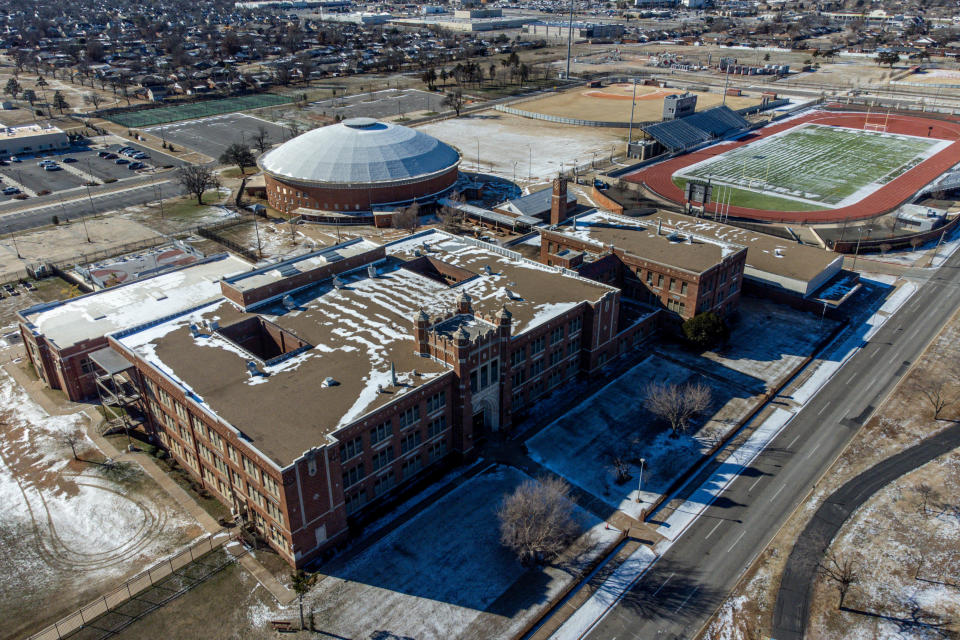
More than 2,700 people have signed a petition pleading with the school district not to destroy the landmark, which was built in 1928.
Preservation Oklahoma placed the building on its 2023 endangered list noting it is structurally sound and eligible for inclusion on the National Register of Historic Places.
Their concerns about the school, while not yet targeted for demolition, date back to renderings by MA+ Architects released in late 2022 that showed the campus cleared of the fieldhouse and the 1928 building. One rendering showed the ornate entrance of the school as the only portion of the school to be retained and for it to be repurposed into a gateway for an alumni plaza.
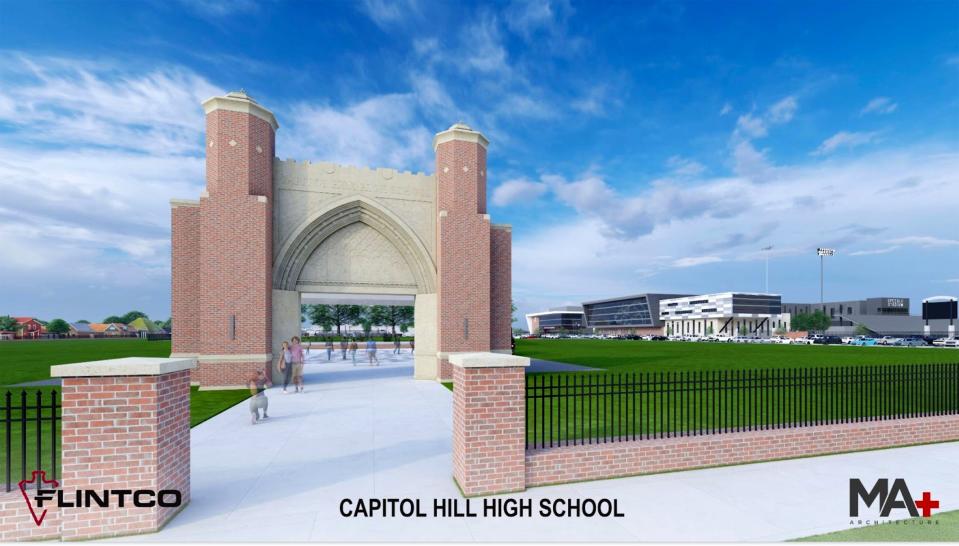
School communications officials declined multiple requests for interviews with McDaniel. OKCPS Board Chair Paula Lewis told The Oklahoman the 1928 building is not fated to be destroyed, though two newer wings will be cleared, as shown in site plans for the new school.
Even the new school has yet to get final approval, though design work is well underway. But construction is scheduled to start this summer with an opening for the 2026-27 school year.
“The board, first of all, has not voted to do anything with either Capitol Hill building,” Lewis said. “That has not been an action item. The bond language did say (it includes) a new Capitol Hill High School.”
History, cost and logistics clash in argument over school's fate
Beyond the architecture and the pedigree of its renowned architect, Capitol Hill High School’s history includes an illustrious list of alums that include former U.S. Rep. Mickey Edwards; rock singer Wanda Jackson; former Major League Baseball star Allie Reynolds; Dick Soergel, who lettered in three sports at Oklahoma State University and J.W. Mashburn, who won a gold medal as part of the relay team at the 1956 Melbourne Olympics.
The C.B. Speegle Stadium on campus is named after the long-time Capitol Hill coach who hosted the first integrated football game in state history. The game on Nov. 3, 1955, featured Speegle’s football team, quarterbacked by Soergel, against the then all-Black Douglass High School, which included Prentice Gautt, who would later become the first Black player at the University of Oklahoma.
McDaniel argued early on for building a new school, saying teaching methods had changed since the school was opened. The classrooms were built when students sat strictly at their desks while teachers delivered a lecture, he said, and that leaves less room for project-based learning for 21st-century students.
And as with any structure almost a century old, operating costs are high. A maintenance audit reviewed every Oklahoma City district school — their strengths, weaknesses and readiness for modern learning — and found Capitol Hill was among the worst.
Costs of a renovation, however, were estimated to be less than new construction.
An evaluation by MA+ Architecture show projections for meeting the 2022 bond issue's goals were initially estimated at $20.5 million for renovating the existing school, much less than the cost of building new at $101.1 million.
The new school's price tag is now estimated at $116 million.
Another issue is Captiol Hill's growing student population, which has made the current building over capacity. According to figures from the Oklahoma Secondary School Activities Association, Capitol Hill’s average daily membership (ADM) has risen from 1,192 during the 2021-22 academic year to 1,389 for the current academic year. That makes it the state’s 28th-largest high school by enrollment.
Lewis said school officials do not want to repeat past decisions, unpopular with students and their parents, that resulted in students being temporarily moved into outside portable classrooms or a nearby shopping center.
“We can't do anything with the building until the kids have a new building to move to,” Lewis said, “But likewise, if … (the old building) was renovated for a school, where do we put 1,400 or 1,500 kids – that's another real issue. And another real issue is where do you find another 30 to 40 acres to build another school if you choose to leave that school?”
Historic Capitol Hill Sports Arena likely to be torn down
To preserve the old building while constructing a new one, some sacrifices to history will have to be made, Lewis said. The Capitol Hill Sports Arena, itself a unique structure with historical and architectural significance, likely will need to be torn down.
“There’s not a great answer here,” Lewis acknowledged, “because we are limited on space.”
Ray Vaughn Sr., the father of Ray Vaughn Jr., former state representative and former Oklahoma County commissioner (and later the first athletic director at what now is Oklahoma Christian University), was the athletic director at Capitol Hill in 1955, when the sports arena opened. In Vaughn Jr.’s book about his father, “More Than A Coach,” he writes of the building being a “first of its kind round-roofed field house.”
The OKCPS Board of Education approved construction of the building on May 11, 1954, with an estimated budget of $1 million, Vaughn Jr. wrote. That’s an amount equivalent to about $11.4 million 70 years later. The low construction bid among the 13 submitted was for $790,000.
Oklahoma City University played the opening game in the sports arena, against Emporia State (Kansas) on Dec. 1, 1955. According to Vaughn Jr.’s book, it was the first college sporting event to be held south of what’s now the Oklahoma River in Oklahoma City.
“I imagine that he was probably one that had to go and explain (to the school board) why we needed it and why it was going to cost so much money,” Vaughn Jr. said of his father. “It was close to a million dollars, which would have made it one of the first buildings ever built at a schoolground for that kind of money. That would have rivaled the buildings out at the fairgrounds. It was a big deal and I got to play in it.”
Even today, the arena is one of Oklahoma’s most unique high school athletic venues. Current Capitol Hill boys basketball coach Leroy Combs played in the arena when he attended district rival Star Spencer High School and says visiting coaches often remark to him about the ambiance of the facility.
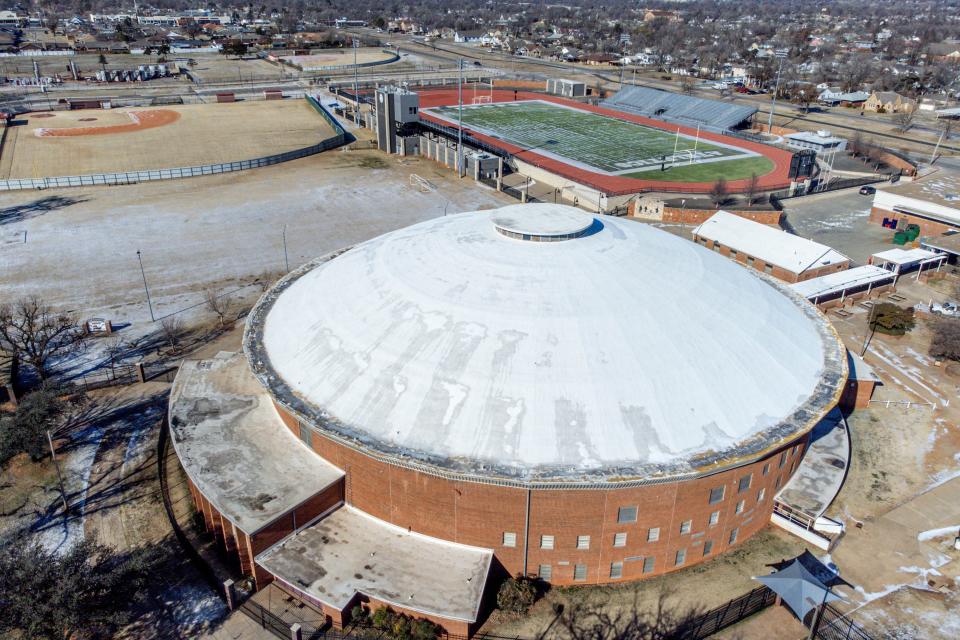
“People love that gym,” he said. “People love being able to play in it.”
That said, Combs acknowledges a long list of structural issues with the stadium. He’s in his eighth season coaching the Red Wolves and for at least two of those seasons, damage to the playing floor has resulted in Capitol Hill playing its entire season away from home, he said.
The facility has had four new and two repaired floors during that time. Water leaks damaged not only the floor but also other areas of the building, including the locker rooms.
“I can say that the gym being torn down is going to crush a lot of people,” Combs said. “I understand this is an issue of money. ... I understand the reasoning behind wanting to tear it down. I am just sentimental to those old gyms.”
Capitol Hill demographics have changed over time
The Capitol Hill community was a predominately white, blue-collar neighborhood when many of the protesting alumni were students in the 1960s and 1970s. The community and the school are now at the heart of a growing Hispanic/Latino population that now accounts for 20.1% of the city’s 694,000 residents. The school's enrollment is 74% Hispanic/Latino.
The alumni and current community leadership agree historic architecture is an important cultural, architectural and commercial asset.
Gloria Torres, director of Calle Dos Cinco in Historic Capitol Hill, served on the Oklahoma City school board from 2014 to 2023 and voted for building the new school.
“The students need modern facilities,” Torres said. “For the growing population in south Oklahoma City, additional space was needed. South Oklahoma City has the highest population of students for Oklahoma City Public Schools. All students want to be in the newest, up-to-date facilities.”
The existing school, she said, should not be torn down without a thorough look at adaptive re-use. The district has found new tenants for older schools throughout the city, ranging from health clinics to after-school programs to charter schools.
“Here in Capitol Hill, we value the history of the buildings,” Torres said. “The school has been a part of this community forever. It’s an icon here. Can it and should it continue as a primary educational facility? I don’t think so. I think our community needs modern facilities for our kids to compete in today’s environment.”
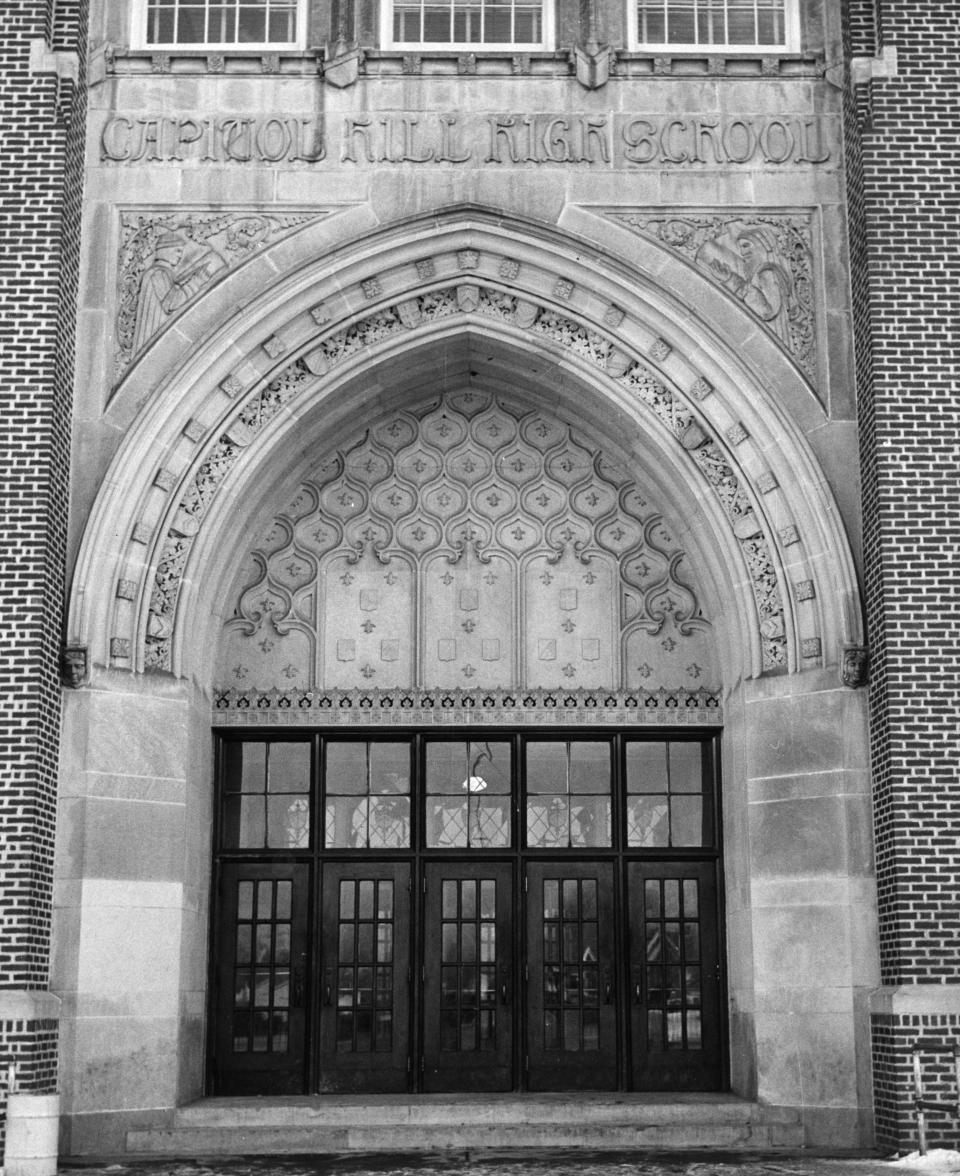
Time ticking on a discussion of whether old building can be repurposed
The arena may be doomed, but Lewis does acknowledge some hope may still remain for the school itself.
McDaniel, the OKCPS superintendent, said in a 2022 interview it was “unlikely” the district could find an alternative to tearing down the old building and constructing a new school.
The current plans, however, only require removing two newer additions to the school that house the cafeteria and gymnasium.
Lewis said she loves the recent renovation and conversion of the former Dunbar Elementary at 1432 NE 7. Built in 1932, the school saw a revival of the surrounding John F. Kennedy neighborhood with construction of 200 new homes over the past 20 years.
But the two-story school itself was closed in 2013, and over the next few years it languished. Fires were set, windows were broken and vandals left ugly tags. Conversion of the school into affordable senior housing was completed in 2019.
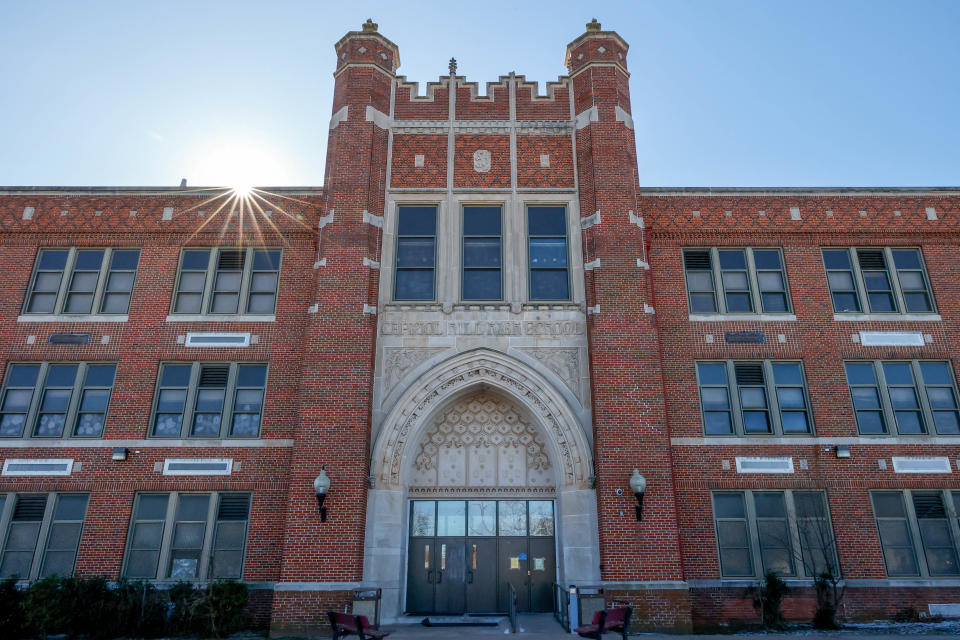
The same neighborhood was also home to the former Page Woodson School at 600 N High Ave. The school was the academic heart of the Black community during the Jim Crow era.
Originally built in 1910 as a white students’ elementary, the school’s Classical Revival red brick building featured ornate detailing by Layton, whose other works included the Skirvin Hotel, the Oklahoma County Courthouse and the former Central High School that is now home to the OCU Law School.
The school closed in 1993 and was plagued with fires and vandalism for 20 years until developers Ron Bradshaw and Gina Sofola bought the school in 2013, along with surrounding vacant parcels, from the Oklahoma City Urban Renewal Authority.
The pair committed not just to bring the school back to life as affordable housing, but to also make its auditorium a community asset and to build dozens of affordable, workforce and market rate apartments over the seven-block spread. The $100 million development is in the final phase of construction and current housing is 95% occupied.
Yet another historic school, the former Harmony Elementary at 1537 NE 24, is being renovated into 20 affordable apartments with the addition of another 20 townhomes on the school’s former playground. In nearby Moore, that school district recently bought that town's old high school building — like Capitol Hill, built in 1928 — with plans to renovate it and use it again as a school.
Bradshaw believes a discussion is needed — and should start soon — on whether Capitol Hill High School could be another candidate for conversion into housing.
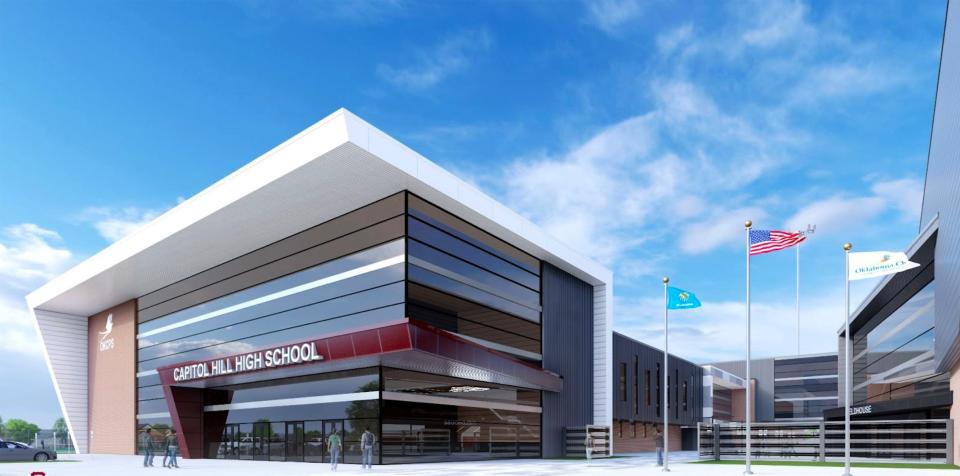
“Is there a need for affordable housing in Capitol Hill?” Bradshaw said. “Affordable means a lot of things to a lot of people. Workforce is one (definition). But affordable is for those who meet 60% of area median income. And it has to be a preference for where people want to live. People aren’t going to move to Capitol Hill for affordable housing.”
The school’s chances for a successful conversion into apartments go up if the surrounding community has a waiting list for affordable housing, Bradshaw said.
Capitol Hill High School is in far better condition than Page Woodson when that redevelopment was proposed. A $10 million renovation at the school funded through the 2001 MAPS for Kids penny sales tax wasn't completed until 2018.
Bradshaw cautions that another question to be asked is whether the school is big enough for a feasible transition into housing.
“It's got to be the right size,” Bradshaw said. “You have to get at least 125 units to make it work. We could not have done Page Woodson with just the school. It's a bigger question as to whether the school might work. It might need an auxiliary building.”
The Oklahoma City Urban Renewal Authority and its umbrella organization, The Alliance for Economic Development of Oklahoma City, played a key role in the Page Woodson and Harmony School projects and is working with the school district to find a developer for the former administration building, previously Roosevelt Middle School at 900 N Klein Ave.
Kenton Tsoodle, alliance president, said he is “very interested” in seeing a conversation started with the school district and potential developers about adaptive re-use of Capitol High School.
“My mother and sister both went to high school there,” Tsoodle said. “A close family friend was a high school coach. I used to go to basketball camps there. I grew up in the area when I was young. I would definitely want to have conversations with (school officials) if they are willing to do so.”
Torres believes the school district is obligated to explore a discussion about the school’s future.
“The schools are in our neighborhoods, in our communities, and we have to be good neighbors,” Torres said. “We need to have someone who can use it, afford to use it, and maintain it where it will be a benefit to our community. And I believe we can do that with Capitol Hill.”
The question is: Who will get the discussion started? Lewis said she welcomes a look at whether the school can be preserved and converted into a new use. But she doesn’t want the school to stay empty and risk becoming an eyesore after the opening of the new school in 2026.
Some of those protesting the potential demolition say they are open to a possible conversion into housing. Others, including Smith, say district officials did a poor job communicating their plans with residents and should still give more consideration into keeping the original school intact. His observation follows a walk-through school officials provided to Smith and his wife, architect Randy Floyd.
“I would like to see it continue as a school,” Smith said. “My research over the last year or so has informed me that there is no reason that the building cannot continue to be used as a school. There are two or three additions on the south side. There are problems with the additions, physical problems. They could be removed. And then a substantial modern addition could be made to the south side of the building that could go on another 100 years.”
This article originally appeared on Oklahoman: Could OKC's old Capitol Hill High School building find a new life?

